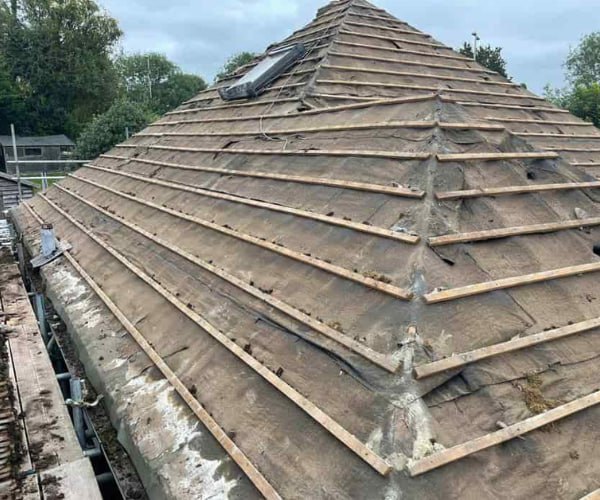When Should You Stop Repairing and Start Replacing Your Roof?
Introduction
Your roof is the primary shield protecting your home from the elements, but like any component of your property, it won’t last forever. Over time, the constant exposure to rain, wind, sun, and seasonal changes takes its toll. Small issues can often be fixed with repairs, but there comes a point where patching up becomes ineffective—or more expensive in the long run—than a complete roof replacement.
At GKL Roofing Tickhill, we regularly help homeowners across Tickhill and South Yorkshire make informed decisions about the condition of their roofs. In this article, we’ll explore the key signs that indicate it may be time to stop repairing and start replacing.
Age of the Roof Matters
One of the most critical factors to consider is the age of your roof. Most roofing materials have a set lifespan, after which they begin to degrade even if they appear fine at a glance.
Typical lifespans by roofing type:
- Asphalt felt flat roofs: 10–20 years
- Concrete tiles: 40–60 years
- Slate roofs: 70–100 years
- EPDM/rubber flat roofs: 25–30 years
If your roof is approaching the end of its expected lifespan, recurring repairs are usually a sign that full replacement is due.
Increasing Frequency of Repairs
If you’re calling a roofer more often than the dentist, it’s a red flag. A roof that’s reaching the end of its useful life will start to fail in different areas, costing you time and money with every new issue.
Signs you’re repairing too often:
- Multiple leaks in different rooms
- Replacing tiles or sections every few months
- Persistent issues with flashing or valleys
- Constantly clearing damp or water ingress
At this point, investing in a new roof is likely to be more economical than constant patchwork that never fully resolves the problem.
Water Damage and Structural Issues
Leaks can sometimes be repaired, but if water has been entering your roof space over a long period, the damage beneath the surface can be far worse than it appears. Rotting timbers, compromised insulation, and mould all point towards a need for replacement rather than repair.
Red flags for deeper water damage:
- Sagging ceilings or visible bulges in plaster
- Mould or mildew in the loft or upper walls
- A musty smell that doesn’t go away
- Damp patches reappearing even after repairs
When the structure itself is at risk, it’s not just a roofing issue—it becomes a serious property concern.
Energy Efficiency Has Declined
An ageing roof can allow heat to escape more easily, causing your energy bills to rise. Gaps, deteriorated insulation, and moisture ingress all reduce the thermal efficiency of your home.
Common signs of reduced energy performance:
- Higher heating bills despite no change in usage
- Draughts coming from loft or roof spaces
- Inconsistent room temperatures
- Roof insulation damp or compressed
Replacing the roof gives you an opportunity to improve ventilation, upgrade insulation, and enhance the overall energy performance of your home.
Aesthetic and Property Value Considerations
A worn-out roof not only affects performance but can also drag down the appearance and value of your property. If you’re planning to sell, an old or visibly damaged roof can be a major deterrent for buyers.
Appearance-related issues:
- Visible sagging or uneven roofline
- Multiple mismatched repair patches
- Discoloured or moss-covered tiles
- Cracked or missing ridge tiles and leadwork
A new roof can dramatically improve kerb appeal, reassuring potential buyers that the home is structurally sound and well maintained.
Cost Comparison: Repair vs Replacement
It’s tempting to keep patching up your roof to delay the expense of a full replacement. But when repairs become too frequent or ineffective, you’re pouring money into a short-term fix. We always advise comparing the long-term costs.
Consider:
- How many times repairs have been made in the last 2–3 years
- The current condition of the entire roof
- The potential damage that could occur if a major failure happens
- The increased property value and insulation benefits of a new roof
At GKL Roofing Tickhill, we help clients understand whether the repair work is still justified or if they’re better off investing in a full, long-term solution.
Conclusion
There’s a time and place for roof repairs—and also a point when they simply won’t cut it any longer. If your roof is ageing, repeatedly leaking, or showing signs of deeper structural damage, it’s worth considering a full replacement before it turns into an emergency.
At GKL Roofing Tickhill, we’re committed to offering honest advice and high-quality roofing solutions across Tickhill and South Yorkshire. Whether you’re unsure about a recent leak or suspect your roof has reached the end of its life, our experienced team can provide a thorough inspection and straightforward guidance.
Get in touch with GKL Roofing Tickhill today to discuss your roofing concerns and find out whether it’s time to stop repairing—and start replacing.
Call us on: 01302 490 497
Click here to find out more about GKL Roofing Tickhill
Click here to complete our contact form and see how we can help with your roofing needs.

